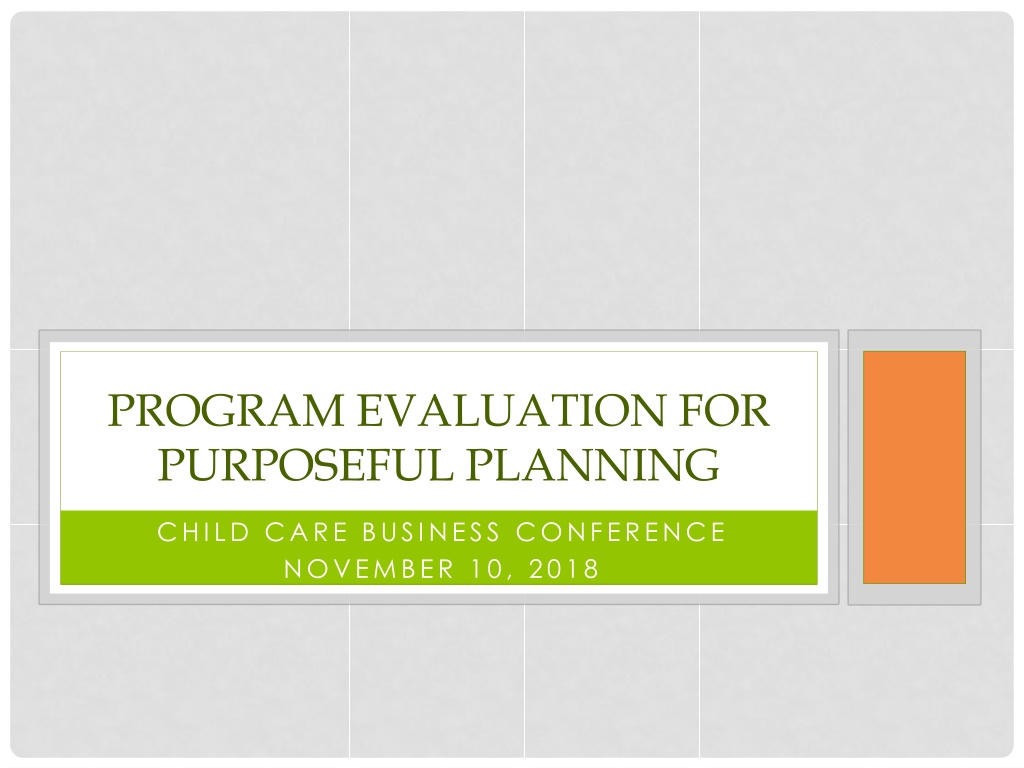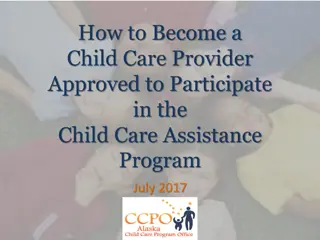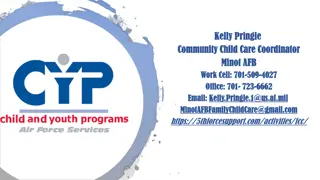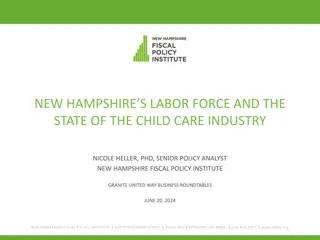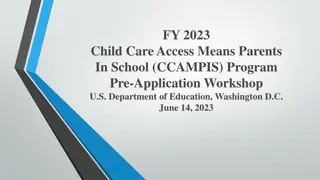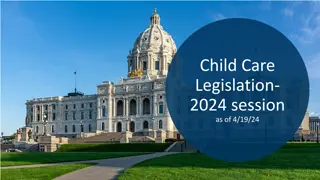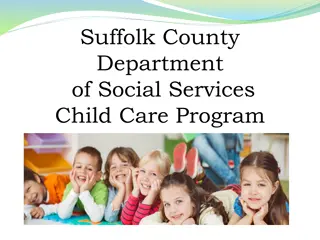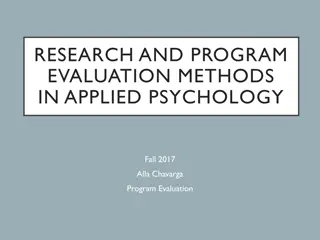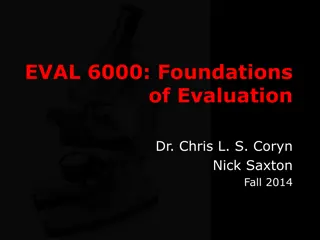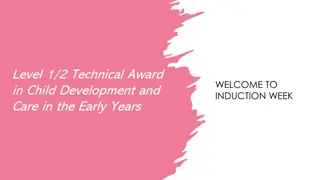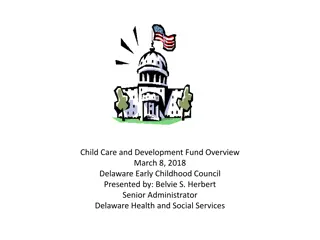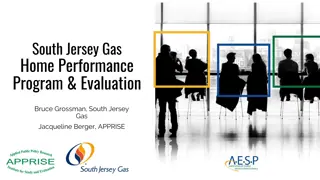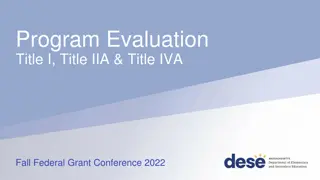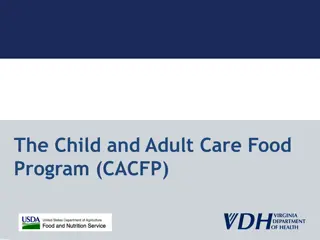Child Care Business Conference Program Evaluation Overview
This program evaluation presentation focuses on understanding how program evaluation leads to purposeful planning and improvement in early learning and development programs. It covers session outcomes, objectives, reflective activities, the importance of evaluating ELDPs, research findings, and NAEYC's position statement on continuous improvement through evaluations.
Download Presentation

Please find below an Image/Link to download the presentation.
The content on the website is provided AS IS for your information and personal use only. It may not be sold, licensed, or shared on other websites without obtaining consent from the author. Download presentation by click this link. If you encounter any issues during the download, it is possible that the publisher has removed the file from their server.
E N D
Presentation Transcript
PROGRAM EVALUATION FOR PURPOSEFUL PLANNING CHILD CARE BUSINESS CONFERENCE NOVEMBER 10, 2018
INTRODUCTIONS: PROFESSIONALS HERE TODAY Name Program Position Community Experience
ICEBREAKER With someone at your table group, discuss: Why did you choose this training? What does program evaluation mean to you? Optional sharing with larger group
REVIEW AGENDA, MATERIALS, OUTCOME, AND OBJECTIVES
SESSION OUTCOME Participants will understand how program evaluation leads to purposeful planning and improvement
SESSION OBJECTIVES Participants will: Examine why it s important to evaluate their programs Explore and examine program evaluation sources Examine and apply program evaluation practices Develop strategies to use program evaluation sources to plan for program improvements
REFLECTIVE ACTIVITY Think/write/draw about why you feel it s important for a program to evaluate their practices Share with at least one other person in your table group
WHY IS PROGRAM EVALUATION IMPORTANT? Collective knowledge activity: Why is it important to evaluate early learning and development programs (ELDPs)?
WHAT DOES THE RESEARCH SAY? Importance of evaluating ELDPs Frequency of evaluating ELDPs
NAEYC POSITION STATEMENT Programs undertake regular evaluation, including self-evaluation, to document the extent to which they are achieving desired results, with the goal of engaging in continuous improvement. Evaluations focus on processes and implementation as well as outcomes. (p.4) A Joint Position Statement of the NAEYC and NAECS/SDE. Early Childhood Curriculum, Assessment, and Program Evaluation: Building an effective, accountable system in programs for children birth through age 8. (2003). Retrieved from https://www.naeyc.org/files/naeyc/file/positions/pscape.pdf .
COMPREHENSIVE PROGRAM EVALUATION All of the following are reviewed: Policies & procedures Family engagement Environment Curriculum Administration & business practices
CAROUSEL BRAINSTORM ACTIVITY Sources which can contribute to meaningful program evaluation: Family Input Program Personnel Feedback/Input Rating Scales or Evaluation Instruments Child Outcome Data Outside Evaluators
OREGONS SPARK Goals of Spark: Raise the quality of child care and early learning programs Provide resources and supports to improve programs Recognize program quality through a rating system Because: Quality programs serve and support the needs of all children
STANDARD AB5 How do the sources you brainstormed support Standard AB5? A comprehensive program evaluation process is developed and performed on an annual basis. The evaluation examines the program s policies and procedures, care and education environment, curriculum, and administration and business practices. (Continued on next slide)
STANDARD AB5 (CONTD) Evaluation sources include: Family input/Family Survey Program personnel feedback/input (or provider self- evaluation) Rating scales or evaluation instruments (for example, ECERS- R/FCCERS-R, Preschool Program Quality Assessment) Child outcome data from assessments Outside evaluators
HOW CAN PROGRAMS ACCESS PROGRAM EVALUATION SOURCES?
SELF-EVALUATION Fill out your Survey on Program Evaluation Practices Add how often (frequency) you use the strategies (once a year, monthly, on-going, etc.)
PROGRAM EVALUATION PRACTICES ACTIVITY Program Evaluation Input Activity
CONTINUOUS QUALITY IMPROVEMENT Using a variety of program evaluation sources to evaluate your program annually is important . . . AND . . . using that information to purposefully plan how to enhance and improve your program s practices can lead to genuine Continuous Quality Improvements
PROFESSIONAL ACTION ACTIVITY Identify at least three program evaluation sources you will use in the coming year and describe how those evaluation sources will help you plan for program improvements
GREEN LIGHT, YELLOW LIGHT, RED LIGHT ACTIVITY Red light would like to stop doing Yellow light would like to continue doing Green light would like to start doing
FOLLOW UP ACTIVITY Programs are encouraged to share your program evaluation plans with your local Child Care Resource & Referral staff/Quality Improvement Specialists
CLOSING Questions? Evaluations THANK YOU!
